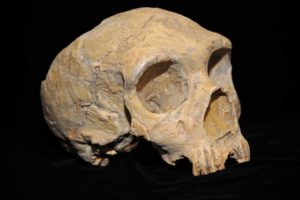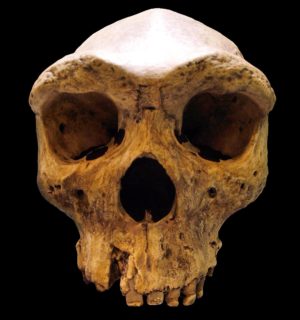
The Royal Society, London—Our closest extinct human species cousins the Neanderthals are, outside of our own species (Homo sapiens), the most studied human species. But researchers are finding that the book is far from closed on our understanding of what the Neanderthals looked like, how they behaved, and what capabilities they demonstrated. Now, a recent study has shed additional light on Neanderthal facial morphology — the structure and form of the face, internal and external — based on an examination and interpretation of the teeth and nasal cavities —by using computer simulations.
Three adaptive hypotheses have been forwarded to explain the distinctive Neanderthal face: (1) improved ability to accommodate high dental anterior [situated toward the front] biting force for food consumption and other possible uses of the teeth; (2) more effective conditioning of cold and/or dry air [warming and humidifying the air that enters the body through the nose]; and (3) adaptation to facilitate greater ventilatory demands [greater volume of air intake/inhale and exhale]. Stephen Wroe, Professor of Zoology at the University of New England, and his colleagues tested these hypotheses by using three-dimensional models of Neanderthals, modern humans, and a close extinct hominid (Homo heidelbergensis — thought by many scholars to be ancestral to Neanderthals), all based on fossil evidence recovered from a variety of sites, and applying finite element analysis (FEA — a numerical method usually used for solving problems of engineering and mathematical physics) and computational fluid dynamics (CFD — a branch of fluid mechanics that uses numerical analysis and data structures to analyze and solve problems that involve fluid flows). The researchers claim that it is the most comprehensive application of either approach applied to date to the subject and the first to include both. The results, according to the research team, show “few differences between H. heidelbergensis, modern humans, and Neanderthals in their capacities to sustain high anterior tooth loadings”*, and that “nasal cavities of Neanderthals and especially modern humans condition air more efficiently than does that of H. heidelbergensis, suggesting that both evolved to better withstand cold and/or dry climates”* than other, earlier Homo species. “We further find that Neanderthals could move considerably more air through the nasal pathway than could H. heidelbergensis or modern humans”*, wrote Wroe, et al., in the study report. The latter findings are consistent with previous hypotheses that Neanderthal facial morphology evolved to reflect improved capacities to better condition cold, dry air, and to move greater air volumes in response to higher energetic requirements.
The study supports the view that Neanderthals were well-adapted to survive and thrive as highly active and successful hunter-gatherers in the climate of glacial and interglacial Eurasia when large Ice Age mammals were present and targets of human hunting.
____________________________

“Broken Hill Skull” from Kabwe, Zambia (replica, Museum Mauer, near Heidelberg, Germany). Type specimen of Homo rhodesiensis, renamed as Homo erectus, also sometimes named Homo heidelbergensis or “archaic Homo sapiens”. Used as one of the models for analysis in the study. Gerbil, Wikimedia Commons
____________________________

Neanderthal skull from Forbes’ Quarry, Gibraltar. Discovered 1848. Used as one of the models in study. AquilaGib, Wikimedia Commons
______________________
* Wroe S. et al., 2018, Computer simulations show that Neanderthal facial morphology represents adaptation to cold and high energy demands, but not heavy biting. Proc. R. Soc. B 285: 20180085.http://dx.doi.org/10.1098/rspb.2018.0085
The study was published in the proceedings of the Royal Society, London.
______________________
See, first-hand, the original fossils. See original artifacts. See the actual sites. Talk with the famous scientists. Join us on this unique specialized study tour.
______________________






One comment on “What’s in a Face: More Light on Neanderthal Facial Structure”